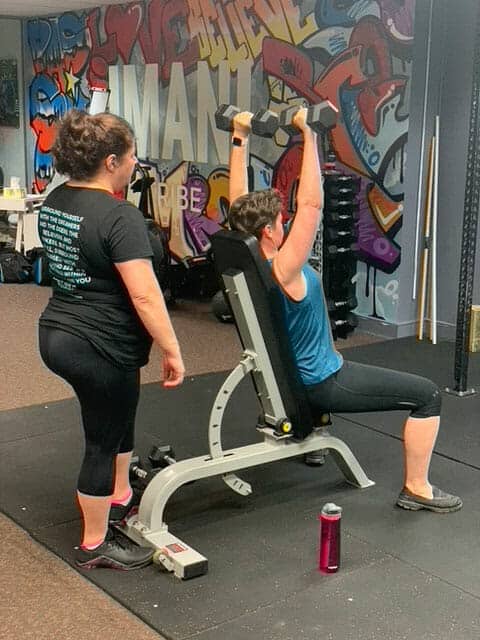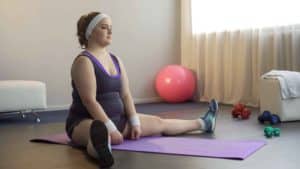You want to lose weight and get fit, so you know you need to start exercising right?
Maybe you’ve been exercising regularly for a while, but the weight isn’t shifting, so you’re thinking that you probably need to add more exercise to your week.
Perhaps you think that adding more cardio will do the trick. Or maybe instead of walking three times a week, you’re thinking of walking every day even though you’re already struggling to keep up with the exercise you’re already doing.
If you’ve been confused about the best workout routine to help you lose weight, you’ve come to the right place.
Exercise Vs training
The first thing you need to understand is that losing weight requires a different approach to exercise than what most people take.
If your goal is to lose weight, you need to make sure that you’re doing the right kind of movement.
Where most people go wrong is not understanding the difference between exercise and training and the impact it has on their weight loss.
Exercise is physical activity done for the sake of being active, in the hope that it will lead to the body you want. The focus is short-term and the purpose is often to make the person exercising feel good about themselves. They like to think they’re doing something ‘good’ for their health, and to burn some calories to offset the guilt they feel at eating poorly.
That’s why there are more people at the gym on a Monday, than any other day. They’re all working to burn off the calories they consumed on the weekend. It doesn’t matter whether they lift weight, run on the treadmill, pedal on the bike, or jump on the rowing machine. As long as they’re moving their body, they’ll burn calories, and that’s all they need to do to lose weight, right?
Wrong.
The best workout routine to lose weight is a training program.
Training is doing physical activity for the purpose of achieving a long-term goal rather than just moving for the sake of it. Training isn’t about doing the exercise you like doing. It’s about doing what you need to do, to have the body you want.
Exercising is being busy and moving for the sake of moving.
Training is being productive because you’re working to achieve a goal.
Training for weight loss and training for fitness
Before we talk too much about the advantages of training, it’s important to understand what you hope to achieve by exercising in the first place.
Most people say they ‘want to lose weight and get fit’. But training for weight loss is different from training for fitness, so you need to be clear on your goal and what you really want to achieve.
A common belief is that adding in more cardio exercise is the way to shed weight. But if weight loss is your goal, your cardio activity needs to be something you’re inefficient at.
However, what most people do is choose one type of exercise – usually one they can already do — and do more of it. But this just means you become more efficient at it, which doesn’t guarantee weight loss.
For example, if a runner decides they want to lose weight, adding more running to his schedule won’t help him burn fat. It will just help him get better at running.
However, if he added swimming or cycling to his workout routine — activities that he doesn’t usually do — then he’ll lose weight because his body is inefficient at these activities.
This is the difference between training for fitness and training for weight loss. This explains why there are people who’ve been going to the gym for years who never get results, or why there are overweight people who can run marathons.
Why training is better than exercise
Training is different to exercising because your workout routine is designed to achieve a certain goal that you have set. For example, this could be weight loss, increased strength, improved mobility or better endurance. Instead of the focus being on what you get out of each individual workout, the focus shifts to the longer-term game. Training is goal-oriented.
A good training program is structured, progressive and personalised in order for you to achieve the goal you’ve set. And it often combines resistance training (aka weights), cardio and other low intensity exercise.
We call them FIRE (Focused Intense Resistance Activity), ICE (Intense Cardio exercise) and LIA (Less Intense Activity) and these three types of exercise are the foundations of our Transformation Program.
A structured training program means that you know what you’re doing each time you do a workout. And you know why you’re doing it. So there’s no more deciding on the day, what type of exercise you feel like doing when you get to the gym. You’re also not wandering around aimlessly, looking for a vacant weight machine or a spare set of dumbbells.
FIRE – the secret to burning fat
While you may think that adding in more cardio is the quickest way to lose weight, because of the calorie burn, a structured FIRE program should be part of your workout routine if you want to lose weight long-term.
That’s because around 66% of our metabolism is influenced by muscle mass. Which means that the more muscle you have, the faster your metabolism, and the easier it is for your body to burn fat. However, a weight program should involve progressive overload if you want to see any physical changes. This means a gradual increase in weight in order to achieve your goal. This gradual increase of stress placed on the body means you’ll build more muscle — which will fire up your metabolism.
The important thing to note is that not all FIRE exercises are the same, so there is no ‘one-size-fits-all’ approach. Not all exercises work for everyone. The ideal program for you is one that will help you reach your goals, and one that your body responds to.
This is why, unlike a cardio program, a FIRE program should remain fairly unchangeable. It’s important to work out what resistance exercises give you the biggest results in terms of body shape change. Any changes to it should be based on what is and isn’t working, and most of the time, these changes should be small.
But if you’re worried about weight training making you bulky, there’s no need. FIRE training will only make you bulky if that’s your goal. And a program that will make you bulky is different to one that will help you lose weight. So once again, it comes down to a personalised approach — what goal YOU want to achieve. Bulk up or slim down — the choice is yours.
Less is more
Finally, the ideal workout routine is one that incorporates rest and recovery. Most people think they need to exercise intensely every day of the week, and sometimes even twice a day. But this will only lead to burnout, injury and poor performance, and make it even harder for you to lose weight and keep it off in the long term.
For most people who are already busy working or running a business, raising teenage kids or looking after aging parents, adding more activity into their week simply creates more stress. And stress is a metabolic blocker, which means it slows down your metabolism and slows down your results.
That’s why at Imani Tribe we only spend 3% of our week working out. We know that consistency trumps intensity every time. It’s far better to do a little less, consistently, than to go hard and then burn out.
In order to ensure our clients can workout consistently throughout the year, we design their workout routine based on their personal goals. All our programs incorporate FIRE, ICE, LIA and scheduled rest and recovery periods.
If you’re sick of exercising for hours and hours a week with little or no result and you’re ready to take a new approach to reach your goals, we’re ready to hear from you.


















